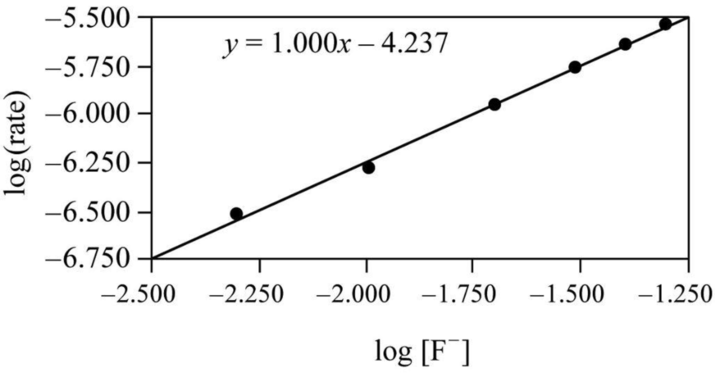
(a)
Interpretation:
The complete rate law for the hydrolysis of benzene sulfonyl chloride in presence of fluoride ion has to be derived.
(a)
Explanation of Solution
The rate is affected by the concentration of Benzenesulfonyl chloride
Where
In order to study the effect of
Therefore the adjusted rate law can be written in the following form.
Adjusted rate
The experiments
It is clear that the concentration change and the adjusted rate change are almost equal, so the fluoride ion concentration and adjusted rate are proportional. Though it is only an approximate relationship, a graph can be drawn by taking log of the rate on y axis and

Figure 1
Therefore it is clear that the reaction is first order with respect to fluoride ion in the adjusted rate law.
So the rate can be written s follows,
(b)
Interpretation:
The rate constant has to be calculated for the hydrolysis of benzene sulfonyl chloride in presence of fluoride ion.
(b)
Explanation of Solution
The rate constant can be determined using the adjusted rate law as follows,
The rate constant can be calculated for the all the experiments with non-zero fluoride ion can be calculated as follows,
Therefore the average value of the rate constant is
Want to see more full solutions like this?
Chapter 11 Solutions
Chemistry: The Molecular Science
- List at least four experimentally determined parameters that you, an experimenter, can define when exploring the hydrolysis of ethyl benzoate by aqueous sodium hydroxide.arrow_forwardIn the hydrogenation of ethylene using a nickel catalyst, the initial concentration of ethylene is 1.70 mol⋅L^−1 and its rate constant (k) is 0.0010 mol⋅L^−1⋅s^−1 . Determine the rate of reaction if it follows a zero-order reaction mechanism.arrow_forwardA gas phase reaction has a rate coefficient of 1.3·104 L mol–1s–1 at 300 K and its activation energy is 8.3 kJ mol–1. Indicate the order of the reaction.arrow_forward
- The rate constant of the reaction H2O2(aq) + I−(aq) + H+(aq) → H2O(l) + HIO(aq) is sensitive to the ionic strength of the aqueous solution in which the reaction occurs. At 25 °C, kr = 12.2 dm6 mol−2 min−1 at an ionic strength of 0.0525. Use the Debye–Hückel limiting law to estimate the rate constant at zero ionic strength.arrow_forwardAt 25 °C, kr = 1.55 dm6 mol−2 min−1 at an ionic strength of 0.0241 for a reaction in which the rate-determining step involves the encounter of two singly charged cations. Use the Debye–Hückel limiting law to estimate the rate constant at zero ionic strength.arrow_forwardThe reaction between fluorine and chlorine dioxide, F2(g) + ClO2(g) → 2FClO2(g) Proceeds according to the following rate Law: r=k⋅PF2⋅PClO2 where k= 0.0489 bar-1 s-1. In an isolation experiment, the initial partial pressures are: PF2(t=0) = 0.04687 bar and PClO2(t=0) = 3.606 bar. Note: Ukeff means units of keff . You need to use a string with no spaces. For example enter gm3 as g*m^{-3} or g/m^3 . (a) Calculate the effective rate constant keff= Ukeff= (b) Compute the pressure of fluorine in bar after 55.8 s. PF2(t=55.8s)= bar (c) How long will it take for the pressure of fluorine to drop to 0.01318 bar? t = sarrow_forward
- Suppose the reduction of nitric oxide proceeds by the following mechanism: step elementary reaction rate constant 1 H,(g) + 2 NO(g) → N20(g) + H,O(g) k1 2 H2(g) + N,0(g) → N,(g) + H,O(g) k2 Suppose also k,«k,. That is, the first step is much slower than the second. Write the balanced chemical equation for the overall chemical reaction: Write the experimentally- observable rate law for the overall chemical reaction. rate = k|| Note: your answer should not contain the concentrations of any intermediates. Express the rate constant k for the overall chemical reaction in terms of k, k2, and (if necessary) the rate constants k.1 and k.2 for the reverse of the tae k =arrow_forwardWrite the difference between order and molecularity of reaction.arrow_forwardSuppose the reduction of nitric oxide proceeds by the following mechanism: step elementary reaction rate constant H,(g) + 2 NO(g) → N20(g) + H,O(g) k1 1 2 H,(g) + N,0(g) → N2(9) + H2O(g) k2 Suppose also k,»k,. That is, the first step is much faster than the second. Write the balanced chemical equation for the overall chemical reaction: Write the experimentally- observable rate law for the overall chemical reaction. rate = k || Note: your answer should not contain the concentrations of any intermediates. Express the rate constant k for the overall chemical reaction in terms of k1, k2, and (if necessary) the rate constants k.1 and k.2 for k the reverse of the two elementary reactions in the mechanism.arrow_forward
- ASAP Predict the product/products of the reaction. Justify your answer and show the mechanismarrow_forwardDefine the molecularity of a reaction and explain how and when this is linked to the reaction order.arrow_forwardSuppose the reduction of nitric oxide proceeds by the following mechanism: step elementary reaction rate constant 1 H,(g) + 2 NO(g) → N,0(g) + H,0(g) k1 2 H2(9) + N,0(9) → N2(9) + H,O(g) Suppose also k, «k,. That is, the first step is much slower than the second. Write the balanced chemical equation for the overall chemical reaction: Write the experimentally- observable rate law for the overall chemical reaction. rate = k U Note: your answer should not contain the concentrations of any intermediates. Express the rate constant k for the overall chemical reaction in terms of k1, k2, and (if necessary) the rate constants k.1 and k-2 for k = the reverse of the two elementary reactions in the mechanism.arrow_forward
 Chemistry: The Molecular ScienceChemistryISBN:9781285199047Author:John W. Moore, Conrad L. StanitskiPublisher:Cengage Learning
Chemistry: The Molecular ScienceChemistryISBN:9781285199047Author:John W. Moore, Conrad L. StanitskiPublisher:Cengage Learning Principles of Modern ChemistryChemistryISBN:9781305079113Author:David W. Oxtoby, H. Pat Gillis, Laurie J. ButlerPublisher:Cengage Learning
Principles of Modern ChemistryChemistryISBN:9781305079113Author:David W. Oxtoby, H. Pat Gillis, Laurie J. ButlerPublisher:Cengage Learning Physical ChemistryChemistryISBN:9781133958437Author:Ball, David W. (david Warren), BAER, TomasPublisher:Wadsworth Cengage Learning,
Physical ChemistryChemistryISBN:9781133958437Author:Ball, David W. (david Warren), BAER, TomasPublisher:Wadsworth Cengage Learning,


